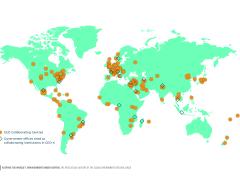Land restoration can make a significant contribution to sustainable development at the global level
A study by PBL Netherlands Environmental Assessment Agency shows that land restoration has global potential to contribute to multiple sustainability challenges, on food and agriculture, water, biodiversity and climate change. This study provides projections on the extent and risks of land degradation, and assesses the potential effects of land restoration compared to a future without restoration. Globally, an estimated five billion hectares of land can be restored through various restoration measures, resulting in improvements to soil carbon, water, agricultural production and climate change mitigation.
Implementing countries’ current land restoration commitments will require 10 years of investment, estimated at 0.04% to 0.21% of annual global GDP. Besides the advantages of land restoration, the disadvantage is that implementation is complex due to the involvement of many different parties. Stimulating land restoration measures therefore requires an integrated and coherent approach to governance and project development. Land restoration can limit but not stop biodiversity loss; this requires additional system changes. June 5th marks the launch of the UN Decade on Ecosystem Restoration (2021-2030).
This PBL study on global restoration scenarios was carried out at the request of the United Nations Convention to Combat Desertification (UNCCD), which was established to combat land degradation, desertification and drought. The Convention addresses the improvement of living conditions of people in drylands and the restoration of degraded land and soils. This PBL study is a central component of the Global Land Outlook, 2nd edition that will be published in early 2022.
A future without land restoration
The Baseline scenario shows what would happen between 2015 and 2050 without land restoration measures. Land management negatively affects soil and biomass productivity on an estimated 12% of the global land area (Figure 1). Agricultural productivity is projected to increase, but current land management practices have an average negative effect of 2%, rising to 6% to 10% in some regions. Cropland expands by about 20% (~300 million ha), at the expense of natural areas. Of the remaining biodiversity, 6% is lost due to land-use change, intensive agriculture and climate change. Average annual carbon emissions between 2015 and 2050 from land-use change and land management amount to 16% of current annual emissions.
New insights into a potential future with restoration
In the Restoration scenario, around five billion hectares are restored using potential land restoration measures. The measures include agroforestry, conservation agriculture, silvopasture, grazing management, grassland improvement, forest plantations, assisted natural regeneration and cross-slope barriers (Figure 2).
Restoration results in multiple improvements in key ecosystem functions
Land condition and ecosystem functions improve between 2015 and 2050 due to the implementation of these restoration measures (Figure 3). Restoration boosts agricultural yields globally by 2% and by up to 10% in some regions, compared to the Baseline scenario. Conversion of natural land to agriculture is reduced and biodiversity loss is 11% less in 2050 compared to the Baseline scenario. Carbon storage in soils increases and loss of carbon in vegetation is reduced, resulting in a net gain of 17 GtC between 2015 and 2050. This can make a substantial contribution to meeting climate ambitions, when compared to current global emissions of 11 GtC/yr.
Current global restoration commitments cover around one billion hectares and therefore one fifth of the potential for restoration in the scenario projections
Of the potential area under the restoration scenarios that is suitable for restoration measures, around 20% is covered under countries’ current restoration commitments (Figure 4). Globally, these restoration commitments cover about 1 billion hectares, and potential area for restoration is estimated at 5.2 billion hectares, under the restoration scenarios. In sub-Saharan Africa, current restoration commitments add up to about half of the estimated area with potential for restoration. Sub-Saharan Africa is one of the regions with the largest share of land affected by land degradation, and it is also the region that is projected to have the highest expansion of agricultural land area up to 2050, underscoring the importance of the large commitments on land restoration in the region. The other regions show much lower coverage by current commitments relative to the potential restoration area.
Land restoration’s strength is also it’s weakness
The multiple potential benefits of restoration draw interest from actors in agriculture and sustainable land use, water, biodiversity conservation, and climate change adaptation and mitigation. This creates the risk of fragmentation in projects and policies. Integrating these actors into projects makes investment decisions complex and increases transaction costs. Fragmented planning, funding and implementation are underscored by the lack of coherence between national plans for land restoration in the Rio Conventions. Estimated costs are highest for sub-Saharan Africa due to the large restoration commitments in this region. The costs of implementing the restoration commitments are likely to be prohibitive for developing countries, unless international cost-sharing mechanisms for restoration are developed. The benefits for livelihoods are also poorly understood. Knowledge on effective policy and governance approaches to bridge this complex distribution of costs and benefits remains scarce.
Moving from commitments to implementation at scale requires an integrated approach
The stimulation of land restoration measures requires an integrated governance approach and enabling environment, to build on the multiple synergies between different sustainable development ambitions, but also address complicated trade-offs. Even in the most ambitious scenario of land restoration and ambitious nature conservation, biodiversity still declines compared to 2015. Combining land restoration and protection measures with changes to production, supply chains and consumption patterns can achieve larger benefits.




